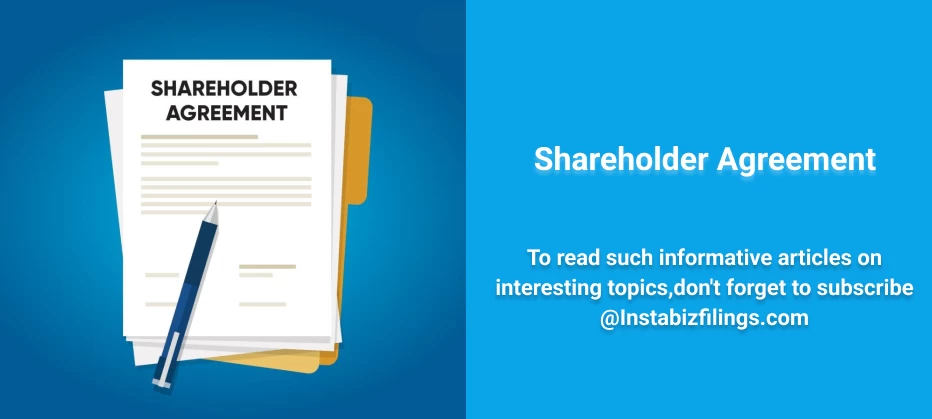
Shareholder Agreement
June 27, 2025 by Team Instabizfilings
What is a Shareholder Agreement?
Shareholder Agreement is a binding document, which states the rights, duties and obligations of shareholders within a company. It controls how the shareholders relate with the company management and the operations of the company. Although a shareholder agreement is not essential to every company, it is highly recommended, especially in the case of private companies, as it enables to secure the interests of people who invest their capitals in the company and establishes how possible disagreements or alterations in the company's structure will be addressed.
Essentially, a shareholder agreement is a contract among the shareholders, and it will give clear conditions under which decisions are made, disputes are resolved, transferring shares, and the situation when one of the shareholders leaves the business.
Why is a Shareholder Agreement Important?
-
Clarifies Shareholder Rights and Obligations: The agreement also sets out the rights, duties and obligations of every shareholder and this assists in avoiding misunderstandings and possible conflicts.
-
Protects Minority Shareholders: Where there are more shareholders in a certain business who agree that the business should be run in a particular manner that gives one shareholder excess control over others, the agreement may help to protect the minority shareholders and give them a voice in key decision-making.
-
Defines Exit and Succession Plans: A shareholder agreement usually provides the procedure and conditions of transferring shares, selling the business, or dealing with the death or incapacity of a shareholder.
-
Helps in Dispute Resolution: When disagreements or disputes occur among shareholders, the agreement usually has the mechanisms of resolving the disagreement or dispute in order to prevent the expensive legal transactions.
-
Facilitates Smooth Business Operations: It also makes sure that there is no disagreement among shareholders on the way the company is managed, on making decisions and on voting, which makes the company run smoothly.
Key Components of a Shareholder Agreement
A shareholder agreement is usually well drafted and it contains the following sections:
- Shareholders' Rights and Responsibilities
-
Voting Rights: It indicates the rights of every shareholder to vote on different issues, including alteration of the company policies, director elections, or mergers and acquisitions.
-
Dividend Rights: Conditions the way and the period at which the dividends should be paid to shareholders.
-
Decision-Making Powers: Specifies the process by which major decisions are to be reached, especially decisions which may entail a majority vote and those which may need unanimous agreement.
- Share Transfer Rules
-
Transfer Restrictions: Defines whether and how shareholders can transfer or sell their shares to other parties, including right-of-first-refusal provisions or buyback rights.
-
Tag-Along and Drag-Along Rights:
-
Tag-Along Rights: Enable minority stakeholders to participate in a sale of shares when a majority shareholder is selling his or her shares.
-
Drag-Along Rights: Allow the majority shareholders to compel the minority ones to sell their shares in case the company is sold.
- Board of Directors and Management
-
States how the board should be composed, how directors are to be elected and their responsibilities. Management structure and responsibility and the procedure of appointing officers may also be described in this section.
-
The agreement may state whether or not shareholders are entitled to nominate directors or managers on the board.
- Exit and Succession Planning
-
Buy-Sell Provisions: Outlines the events on which the shares should be purchased or sold particularly on deaths, disability, bankruptcy, or retirement of a shareholder.
-
Valuation of Shares: explains the valuation of the company shares in case one of the shareholders wants to sell his/her shares or upon the death of a shareholder.
-
Exit Strategy: Establishes the mutual formula of an exit, either in a form of a sale, merger or a public offering.
- Dispute Resolution
-
Arbitration or Mediation: In many cases, the agreement shall contain a clause that stipulates that all disagreements among the shareholders shall not be litigated but solved through arbitration or mediation.
-
Deadlock Provisions: The agreement can also include a tie-breaking mechanism in case of a deadlock among the shareholders (e.g. they cannot agree on a crucial decision).
- Confidentiality
-
Assures the shareholders of confidentiality concerning sensitive business information, before and after they take part in the company.
- Non-Compete and Non-Solicitation Clauses
-
In many cases, shareholders will enter into agreements not to carry on competing businesses whilst they are involved with (and sometimes following their association with) the company. They can also enter into an agreement that they will not take away employees or customers of the business.
- Distributions of Profits
-
Describes the way in which profit will be shared among the shareholders. This can be different according to the percentage of ownership of a shareholder or any other special agreement amongst shareholders.
Types of Shareholder Agreements
-
Unanimous Shareholder Agreement (USA) : A USA is an accord whereby all the shareholders consent on the terms and conditions in the shareholder accord. It is normally employed to make sure that no decisions are taken without the complete concurrence of all the parties involved.
-
Standard Shareholder Agreement : This is a more widespread type of agreement according to which the simple majority of shareholders may vote. It usually covers voting, transfer of shares and control of management.
-
Drag-Along and Tag-Along Agreements : Such arrangements are critical especially in a business that has been financed through private equity or venture capital. They address the rights of minority shareholders upon a sale, and make sure that they are either able to tag along or are dragged along with the sale of a company.
Advantages of a Shareholder Agreement
-
Clarity and Structure: Rights and responsibilities of every shareholder are clearly stated in the agreement, and there cannot be any misunderstanding regarding the expectations and tasks.
-
Dispute Prevention and Resolution: The agreement also minimizes the chances that the disagreements may develop into costly legal tussles because they have outlined mechanisms of settling disputes in advance, and in an efficient manner.
-
Protects Minority Shareholders: It also guarantees protection of minority shareholders against compulsion and dilution of their shares by the majority shareholders.
-
Prevents Unwanted Transfers: The shareholder agreements usually include the so-called right of first refusal, according to which the shares cannot be sold to a third party without offering them to the current shareholders first.
-
Supports Smooth Transitions: In the event of the death, retirement or exit of one of the shareholders, the agreement will secure the future of the company as there will be prior arrangements on how the company will be bought out or transferred.
Disadvantages of a Shareholder Agreement
-
Complexity: The process of preparing a shareholder agreement may be tricky, particularly where the company involves numerous shareholders or has a complicated business structure. It frequently needs the assistance of law specialists.
-
Potential Conflicts: Although the agreement is supposed to avoid any disagreements, some shareholders are likely to believe that the agreement is not fair and this might cause internal conflict.
-
Binding Commitment: Once in existence shareholder agreements may be hard to alter, which has the effect of keeping shareholders under an obligation of the agreement until such a time that modifications are official and legal.
When Should You Create a Shareholder Agreement?
It is advisable to create a shareholder agreement when:
-
The company possesses several shareholders, be it founders, investors or any other important people.
-
You would like to see the business run in a smooth manner and there are clear and accepted rules governing the relationship of shareholders.
-
You want to support your rights as a minority or majority shareholder.
-
You fear the possible departure or conflicts among shareholders.
-
Your company is looking to make future investments or intends to acquire capital by external investors.
Conclusion
An essential tool that any company which has multiple shareholders should use is the Shareholder Agreement since it provides clarity, protection, and dispute resolution mechanisms. Although the agreement may be tricky and needs to be looked at critically, its advantages surpass the risks that it may pose especially in safeguarding the interest of all the parties involved as well as the survival of the company.
When you are establishing a business with other stakeholders or you are party to the management of an established business, it is important to develop a shareholder agreement as part of safeguarding the business and the shareholders.
Disclaimer
The information provided in this blog is purely for general informational purposes only. While every effort has been made to ensure the accuracy, reliability and completeness of the content presented, we make no representations or warranties of any kind, express or implied, for the same.
We expressly disclaim any and all liability for any loss, damage or injury arising from or in connection with the use of or reliance on this information. This includes, but is not limited to, any direct, indirect, incidental, consequential or punitive damage.
Further, we reserve the right to make changes to the content at any time without prior notice. For specific advice tailored to your situation, we request you to get in touch with us.


